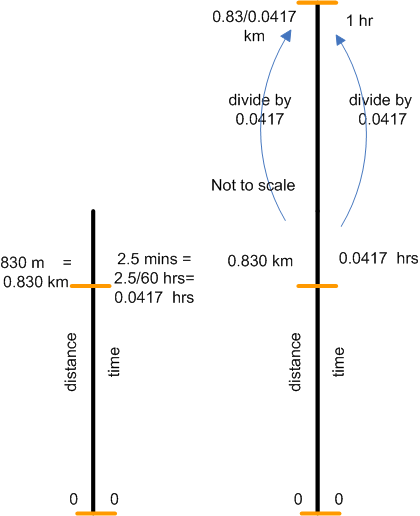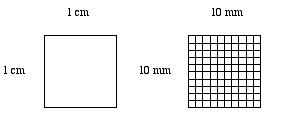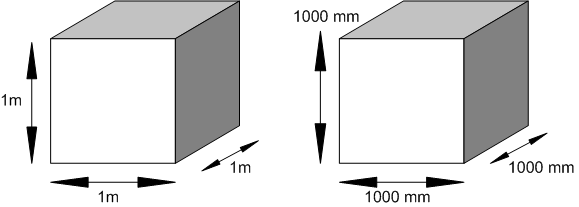Converting Between Derived Units: 5.25
Supporting Materials
- Related Progression Points
- Developmental Overview of Measurement Attributes (PDF - 30Kb)
- Developmental Overview of Proportional Reasoning and Multiplicative Thinking (PDF - 41Kb)
Indicator of Progress
Success in converting between derived units depends on converting each component unit carefully, and using proportional reasoning (definition) on each of them.
Many students will use a conversion factor for only one unit, neglecting the other(s).
At this level (5.25), students can convert between derived units including those for measuring rates. At the next level (5.5), students have a well-established understanding of the nature of derived units (especially those of rate) and can use them to solve problems involving scientific quantities and a mix of units.
Note: A derived unit measures a quantity made from a combination of other quantities. For example, 1 cubic centimetre (derived unit) is the volume of a cube with side lengths 1 centimetre. An object has a speed of 1 km per hour (derived unit) if it travels 1 kilometre in one hour. Other common derived units are for rates including unit prices (e.g. cost per gram of coffee), density (mass per unit volume), flow of liquid (litres per minute), etc.
For more information see: More about units.
Illustration 1: Common errors
Students often say there are 100 square centimetres in a square metre, and 100 cubic centimetres in a cubic metre. They are not visualising the quantities involved, but are recalling a known conversion without thinking carefully about the real situation.
In converting other derived units (e.g. metres per second to kilometres per hour) students will often attend to only one of the two factors involved, or be unsure whether to multiply or divide. Success requires good proportional reasoning.
Teaching Strategies
The teaching strategy for conversion of square and cubic units has two components. Firstly, students have to be made aware that these situations are to be approached with care, because mistakes are likely. Secondly, they need to be given a strategy for visualising the situation and calculating the answers.
Activity 1: Raising awareness of a likely error is designed to raise students' awareness of likely errors.
Activity 2: Converting between units for areas and between units for volume suggests that students support their calculations with a visualisation strategy.
Activity 3: Converting between derived units provides a first principles approach to assist students to decide when to divide and when to multiply.
Activity 1: Raising awareness of a likely error
Everyone makes mistakes in mathematics. But not everyone corrects them!
It is natural to think that the conversion factor for centimetres to metres also applies for square centimetres to square metres. Students need to develop an internal monitor that warns them to double check in conversion situations.
This teaching episode may be short, but it is intended to make a lasting visual impression, so teaching aids of the right dimensions are required. They will be a valuable acquisition for the school.
| Area | Volume |
|
Equipment One square metre of cardboard, measuring 1m by 1m, plain on one side, and ruled on the other side into 1 cm squares. |
Equipment A cardboard or other box, measuring 1m by 1m by 1m. |
|
Procedure Before bringing out the material, ask students how many square centimetres in 1 square metre (without any visual aids). Some students will answer 100. Show the square metre of cardboard plain face up, and ask students to cover it with 100 of the small squares. Only a tiny amount of the big square will be covered (1%). To find out how many small squares will actually be needed, turn the cardboard over and count up row by row. Emphasise that 100 rows of 100 squares are needed. |
Procedure Before bringing out the material, ask students how many cubic centimetres in 1 cubic metre (without any visual aids). Some students will answer 100. Show the cubic metre box, establish that it is one cubic metre and ask students to place 100 of the small cubes in the box. Only a tiny percentage will be filled (in fact only 0.01%). To find out how many small cubes will actually be needed, count the bottom layer (100 by 100), then the second bottom layer etc. In all, there are 100 layers and each layer has 100 × 100 little cubes. (The 1 square metre cardboard square might be useful to show the layers). |
Activity 2: Converting between units for area and between units for volume
Visualisation is the key to correct conversions. Students should draw a sketch, similar to the one shown below, to guide the conversion, until they can work with just a mental picture. Usually the sketch will not be able to show the exact number, but will just indicate the numbers involved as in the second diagram.
Emphasise that the role of this diagram is to help with the conversion, rather than with the problem context. For example, to convert the area of a circle from 628 318 square centimetres to square millimetres, the square diagram below would be drawn.
|
AREA
|
SI unit: square metre (m2) |
||||||
|
100 square millimetres (mm2)
|
= 1 square centimetre (cm2)
|
||||||
NOTE: The illustration has been enlarged, |
|||||||
|
VOLUME
|
SI unit: cubic metre (m3)
|
||||||
|
1000000000 cubic millimetres (mm3)
|
= 1 cubic metre (m3)
|
||||||
|
|
|||||||
Activity 3: Converting between derived units
The difficulties in converting between derived units involve
- not converting each factor and
- losing track of the proportional reasoning involved.
Converting the units at the beginning of the problem is conceptually the easiest way, although sometimes it involves more difficult calculations than converting at the end. It always relies on good proportional reasoning, and often on understanding of division by numbers less than 1. The example below shows the unitary method (going back to one unit).
Encourage students to set out their reasoning step by step as shown below, when in doubt. The use of the dual number line as a visual aid is highly recommended. For more information Easy and hard ratio and proportion questions (Level 5.5) addresses concepts about the dual number line.
 |
|
Example. An emu ran 830 m in 2.5 minutes. What was the emu's average speed in km/hr? An emu ran 830 m in 2.5 minutes. The emu ran 0.830 km in 2.5 minutes. The emu ran 0.830 km in 2.5/60 hours. The emu ran 0.830 km in 0.417 hrs. The emu ran 0.830/0.417 km in 1 hour Calculate to find that the emu's average speed was 19.90 km per hr. (The NSW National Parks and Wildlife Service website (http://www.nationalparks.nsw.gov.au) says that an emu can run at up to 50km/hr.) This example is intended to illustrate the use of the dual number line. Teachers can construct their own examples eg using data from students' running, travel to school, etc. Teachers will also make links from the name of the unit for speed to the definition of (average) speed as distance travelled divided by time taken. |
Proportional reasoning explained
Proportional reasoning is the thinking required in the very wide range of situations where multiplication and division is involved. Multiplicative thinking is the same thing, provided it is understood to include division. Topics which involve proportional reasoning include converting units, fractions, all multiplication problems, constructing scales, linear graphs, percentages, ratio and proportion problems, speed, density, other derived units, similar triangles, trigonometry etc.
References
The NSW National Parks and Wildlife Service website - (http://www.nationalparks.nsw.gov.au)
52 = 5 squared.
1/2 = one half.


